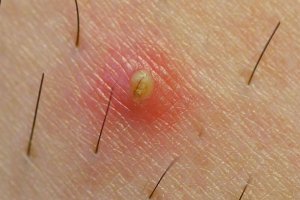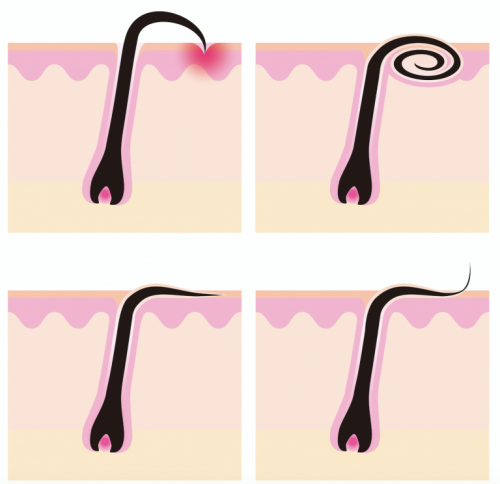How to Prevent Ingrown Hair

Ingrown hair is hair that’s been removed and that grows back beneath the skin. When this happens, it usually causes some slight pain and inflammation. Bumps will also appear where the hair follicle is.
Ingrown hairs can affect any person who removes body hair. It doesn’t matter if you remove hair with a razor, tweezers, or wax. They happen more frequently when coarser hair is removed, like in a man’s beard. With that said, anyone can have an ingrown hair anywhere on the body where hair’s been removed.
While these hairs don’t usually pose any risk whatsoever, they can be quite annoying. They can appear on the face, scalp, armpits, pubic area, and legs. Want to know more? We’ll tell you all the details.
Why Does Ingrown Hair Happen?
The factor that determines ingrown hairs is the structure of the hair itself and the direction in which it grows. For example, curved hair follicles make it easier for the hair to re-enter the skin after removing it.

When some hair begins to grown again, it grows beneath the skin. Some of these hairs are very sharp after shaving. This tends to happen particularly when the hair is dry at the time of shaving.
Also, there’s an increased risk of developing ingrown hairs when tweezing. Tweezers tend to leave fragments that grow inside the skin. Along these lines, an article published in the Merck manual also points out that there is a greater risk of developing ingrown hairs when the skin is tense before waxing or shaving.
Also read: 6 Recommendations for the Prevention of Ingrown Hairs
The Best Way to Prevent Ingrown Hair
The best way to prevent ingrown hairs is by not removing hair. Human beings have hair on every surface of the body except for the soles of the feet, the palms of the hands, and in the mucous membranes.
It is there to protect the skin and not for aesthetic purposes. Hair protects the body from dust, dirt, the sun, and the wind. It also plays an important role in defending against bacteria and other microorganisms. The Nemours Foundation also defends its role as an insulator, as it helps regulate temperature.
The hair on our body also absorbs sweat so that it does not cause any skin irritations or rashes. It also redirects sweat to other areas of the body that need it more or to dry other areas. As mentioned before, hair removal affects the natural growth of hair and avoiding hair removal is the best way to avoid complications.
We also recommend: 5 Natural Solutions for Ingrown Hairs
How to Prevent Ingrown Hair
If a person doesn’t want to do without hair removal, they should at least take some preventive measures to reduce the likelihood of suffering from annoying ingrown hairs. The measures most recommended by experts are the following:
Before shaving
- Exfoliate regularly. This allows your pores to remain clean and hydrates your skin. This also makes hair removal easier and gives you smoother results.
- Hydrate your skin well. When you don’t drink enough water, your skin becomes tougher and drier. This makes it difficult for the hair to break through the skin and grow correctly.
- Prepare your skin with warm water before hair removal. Before removing hair, you should moisten your skin with warm water. This helps the pores open and lowers the likelihood of ingrown hairs developing.
- Moisturize. It’s a good idea to apply a gel or moisturizing cream before shaving. This moisturizes the skin and softens the hair.

While shaving
- Use the right blade. It’s best not to use the same razor more than three times. The razor becomes dull and can damage the skin. There’s no concrete evidence that the more blades a razor has the better. Each person should try a few different types of razors and decide which one is best for them.
- Shave properly. You should shave in the same direction that the hair grows. This doesn’t alter the natural growth of the hair as much as shaving against the hair growth.
- Don’t tighten the skin. You should avoid tightening the skin during hair removal. This causes the hair to retract and become ingrown once the skin loosens.
- Clean properly. After shaving, the razor should be rinsed. You should also rinse the area that was shaved very well then apply lotion to the area.
The danger behind ingrown hairs
Although most ingrown hairs on the skin arise by chance and are harmless, it’s important to be aware of their appearance. Complications can arise as a result, including infections, scarring, darkening, etc. These must be solved by prescribed treatments in the form of creams or pills.
Therefore, prevention is the best medicine. Along these lines, if they appear on a regular basis, you should see a dermatologist. This professional will advise you in detail on all the steps to follow.
All cited sources were thoroughly reviewed by our team to ensure their quality, reliability, currency, and validity. The bibliography of this article was considered reliable and of academic or scientific accuracy.
- Vellos encarnados. Mayoclinic, en línea: https://www.mayoclinic.org/es-es/diseases-conditions/ingrown-hair/symptoms-causes/syc-20373893.
- Porriño, ML, Sánchez, J, Almodóvar, A, García, JM, Arias, S, & Carriel, V. (2014). El folículo piloso: una importante fuente celular en ingeniería tisular. Revista argentina de dermatología, 95(1), 38-46. Recuperado en 11 de julio de 2020, de http://www.scielo.org.ar/scielo.php?script=sci_arttext&pid=S1851-300X2014000100008&lng=es&tlng=es.
- Pelos encarnados en la barba (Pseudofoliculitis de la barba). 2019. Merck and Co., Inc., Kenilworth, NJ, USA. https://www.msdmanuals.com/es-es/hogar/breve-informaci%C3%B3n-trastornos-de-la-piel/trastornos-del-pelo/pelos-encarnados-en-la-barba.
- Khanna, N., Chandramohan, K., Khaitan, BK y Singh, MK (2013). Foliculitis posterior a la depilación: una evaluación clínico-patológica. Revista Internacional de Dermatología, 53 (7), 849–854. https://doi.org/10.1111/ijd.12056.
- Larissa Hirsch, MD (2019). La piel, el cabello y las uñas. The Nemours Foundation. https://www.nemours.org/welcome.html?utm_source=khreview&utm_medium=nem&utm_campaign=larissa-hirsch.
This text is provided for informational purposes only and does not replace consultation with a professional. If in doubt, consult your specialist.








